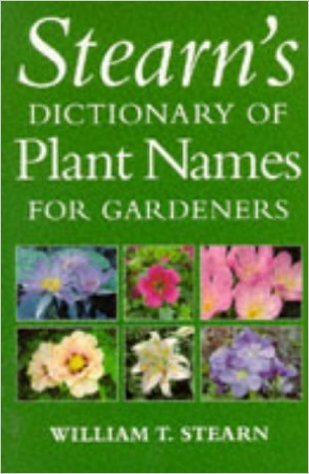 The botanical names for plants are often unfamiliar and challenging to pronounce so many gardeners avoid them. Sterns Dictionary of Plant Names for Gardeners is a giant step towards becoming comfortable with botanical names by providing the meaning and origin of 6,000 botanical names that are most likely to be encountered by gardeners and horticulturists. Help with pronunciation is provided by general comments on pronouncing Latin words as well as specific syllable stress information for all words.
The botanical names for plants are often unfamiliar and challenging to pronounce so many gardeners avoid them. Sterns Dictionary of Plant Names for Gardeners is a giant step towards becoming comfortable with botanical names by providing the meaning and origin of 6,000 botanical names that are most likely to be encountered by gardeners and horticulturists. Help with pronunciation is provided by general comments on pronouncing Latin words as well as specific syllable stress information for all words.
An introductory chapter explains binomial nomenclature, and the correct pronunciation of Latin words including the issue of gender, number, and word endings. The bulk of the book is devoted to alphabetically listing generic name and specific epithets. Entries for generic names include pronunciation guide, gender of the word, the Greek or Latin word/s from which the word is derived, the meaning of the words, how it may relate to the plant bearing the name, and the family to which the word belongs. For example the entry for Abrophyllum reads:
Abrophyl’lum n[neuter]. Gr [Greek]. Abros, delicate; phyllon, a leaf. The leaves of these Australian shrubs have a delicate appearance. ESCALLONIACEAE
In a similar way the entries for the specific epithets give a pronunciation guide, gender endings when applicable, and meaning. The entry for saponaceus, for example, is:
Sapona’ceous, -a, -um Soapy
When a term is derived from the name of a person some information about the person is provided. An example is Pueraria;
Puera’ria f [feminine] Named for Marc Nicolas Puerari (1766-1845), Swiss botanist, born a Geneva, who spent most of his life as a professor at Copenhagen, bUt gave his important herbariums to De Candolle of Geneva. LEGUMINOSEAE
Of course, I would like even more information but given the constraints of including over 6000 terms in a single volume I must be content and besides this book is the best that is available in regard to botanical etymology. In addition to the genera and specific names, the book includes a list of vernacular, or common names, giving the botanical name for each so you can look up both genus and species in the other part of the book. All though a bi dry, the book is of great value in learning botanical names and key characteristics of garden plants.
To buy Stearn’s Dictionary of Plant names for Gardeners from Amazon.com Click Here.